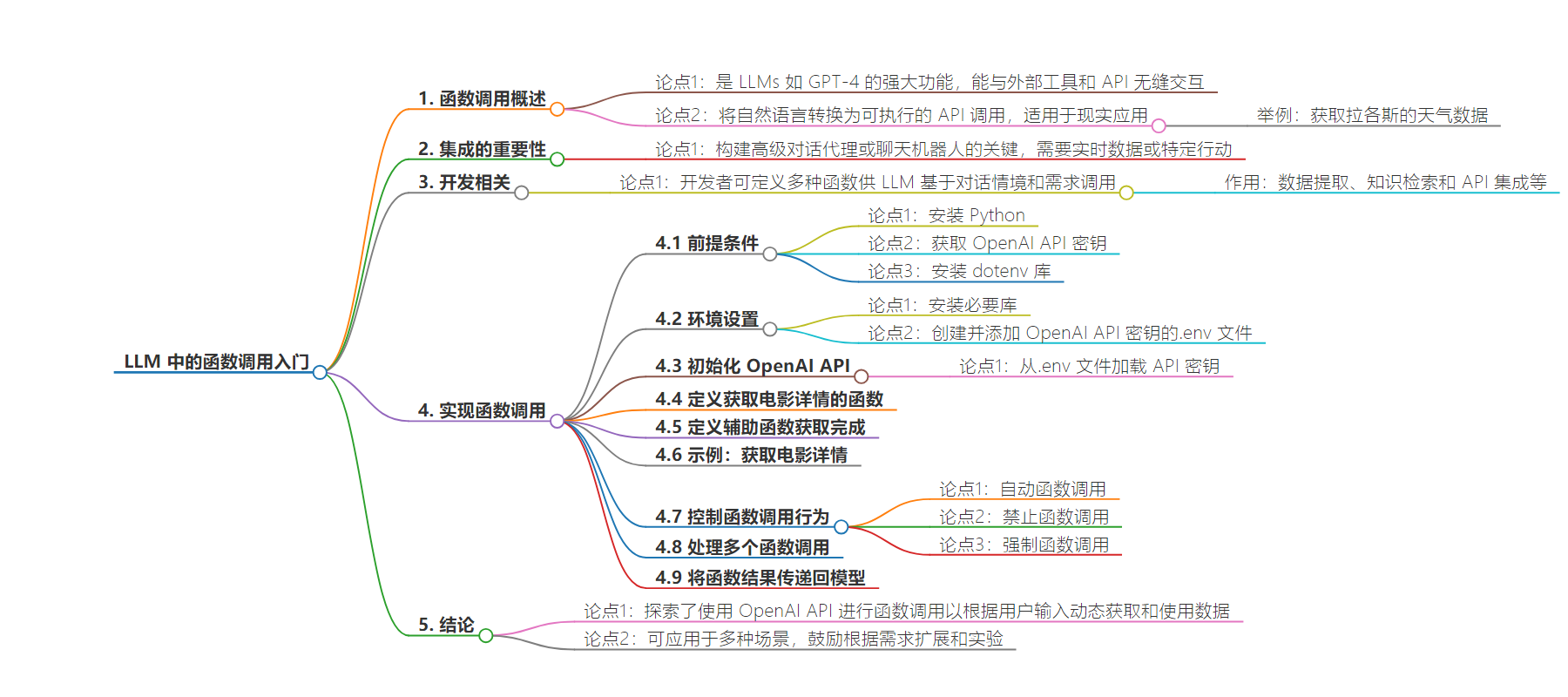包阅导读总结
1.
“`
Function Calling、LLMs、OpenAI APIs、Movie Details、Applications
“`
2.
Function calling is a powerful feature in LLMs like GPT-4. This guide explains its implementation using OpenAI APIs, covering prerequisites, environment setup, function definitions, control of calling behavior, handling multiple calls, and passing results back. It aims to enhance LLM applications’ capabilities and interactivity.
3.
– Getting Started With Function Calling in LLMs
– Function calling enables LLMs to interact with external tools and APIs
– Allows conversion of natural language to API calls for real-world applications
– Essential for building advanced conversational agents or chatbots
– Enhances LLM capabilities to be more conversational and responsive
– Prerequisites and Setup
– Requires Python installation, OpenAI API key, and dotenv library
– Install necessary libraries and set up environment variables
– Function Definitions and API Interaction
– Define function to get movie details from a dummy database
– Define it as a tool for OpenAI API
– Helper function for API requests and response processing
– Controlling Function Calling Behavior
– Options for automatic, no, or forced function calling
– Supports multiple function calls in one turn
– Pass function results back to the model for further processing
– Conclusion
– Tutorial explores dynamic data fetching based on user input
– Applicable to various use cases, encourages customization
思维导图:
文章地址:https://thenewstack.io/getting-started-with-function-calling-in-llms/
文章来源:thenewstack.io
作者:Oladimeji Sowole
发布时间:2024/8/9 13:19
语言:英文
总字数:625字
预计阅读时间:3分钟
评分:86分
标签:函数调用,大型语言模型,OpenAI API,API 集成,对话代理
以下为原文内容
本内容来源于用户推荐转载,旨在分享知识与观点,如有侵权请联系删除 联系邮箱 media@ilingban.com
Function calling is a powerful capability in large language models (LLMs) like GPT-4, allowing these models to interact seamlessly with external tools and APIs. This functionality enables LLMs to convert natural language into actionable API calls, making them more versatile and useful in real-world applications. For instance, when a user asks, “What is the weather like in Lagos?” an LLM equipped with function calling can transform this query into a function call to a weather API in Lagos, Nigeria, retrieving the current weather data there.
This integration is essential for building advanced conversational agents or chatbots that require real-time data or need to perform specific actions. Function calling allows developers to define various functions that the LLM can call based on the context and requirements of the conversation. These functions act as tools within your LLM application, enabling tasks such as data extraction, knowledge retrieval and API integration.
With function calling, developers can enhance LLMs’ capabilities, making them conversational, interactive and responsive to user needs. This guide will walk you through the steps to implement function calling using OpenAI APIs, providing a simple, practical example to illustrate the process to enhance the capabilities of our language model (LLM) application. This step-by-step guide with code snippets will demonstrate how to define and call functions dynamically based on user input. We’ll use a movie database to fetch movie details.
Prerequisites
- Python is installed on your machine.
- OpenAI API key.
- dotenv library to manage environment variables.
Setting Up the Environment
First, let’s set up our environment and install the necessary libraries.
pip install openai python-dotenv
Next, create a .env file in your project directory and add your OpenAI API key:
OPENAI_API_KEY=your_openai_api_key
Initialize OpenAI API
Load the API key from the .env file and set it up in your script.
Set OpenAI API Key
openai.api_key = os.getenv('OPENAI_API_KEY')
Define a Function to Get Movie Details
We’ll create a function that fetches movie details from a dummy movie database.
Define the Function of the API
Now, we’ll define this function as a tool for the OpenAI API to use.
Define a Helper Function to Get Completion
This function will handle the API requests and process the responses.
Example: Fetching Movie Details
Let’s create a conversation where the user asks for movie details and the LLM calls our function to get the necessary information.
Controlling Function Calling Behavior
You can control whether the model should call a function automatically.
Automatic Function Calling
The model decides on its own whether to call a function.
get_completion(messages, tools=tools, tool_choice="auto")
No Function Calling
If you want to force the model to not use any of the functions provided, the code snippet below gives an example of how to implement this.
get_completion(messages, tools=tools, tool_choice="none")
Forced Function Calling
To force the model to call a specific function, you can implement:
get_completion(messages, tools=tools, tool_choice={"type": "function", "function": {"name": "get_movie_details"}})
Handling Multiple Function Calls
The OpenAI API supports calling multiple functions in one turn. For example, fetching details for multiple movies:
Passing Function Results Back to the Model
You might want to pass the result obtained from your API back to the model for further processing.
Conclusion
In this tutorial, we explored how to use function calling with OpenAI API to dynamically fetch and use data based on user input. By defining functions and controlling their invocation, you can create more interactive and capable applications. This method can be applied to various use cases, such as querying databases, calling external APIs or performing calculations.
Feel free to extend this example to suit your specific needs and experiment with different functions and behaviors. Happy coding!
YOUTUBE.COM/THENEWSTACK
Tech moves fast, don’t miss an episode. Subscribe to our YouTubechannel to stream all our podcasts, interviews, demos, and more.
